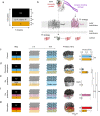Droplet printing reveals the importance of micron-scale structure for bacterial ecology
- PMID: 33558498
- PMCID: PMC7870943
- DOI: 10.1038/s41467-021-20996-w
Droplet printing reveals the importance of micron-scale structure for bacterial ecology
Abstract
Bacteria often live in diverse communities where the spatial arrangement of strains and species is considered critical for their ecology. However, a test of this hypothesis requires manipulation at the fine scales at which spatial structure naturally occurs. Here we develop a droplet-based printing method to arrange bacterial genotypes across a sub-millimetre array. We print strains of the gut bacterium Escherichia coli that naturally compete with one another using protein toxins. Our experiments reveal that toxin-producing strains largely eliminate susceptible non-producers when genotypes are well-mixed. However, printing strains side-by-side creates an ecological refuge where susceptible strains can persist in large numbers. Moving to competitions between toxin producers reveals that spatial structure can make the difference between one strain winning and mutual destruction. Finally, we print different potential barriers between competing strains to understand how ecological refuges form, which shows that cells closest to a toxin producer mop up the toxin and protect their clonemates. Our work provides a method to generate customised bacterial communities with defined spatial distributions, and reveals that micron-scale changes in these distributions can drive major shifts in ecology.
Conflict of interest statement
The authors declare no competing interests.
Figures




Similar articles
-
Dynamics of ColicinE2 production and release determine the competitive success of a toxin-producing bacterial population.Sci Rep. 2020 Mar 4;10(1):4052. doi: 10.1038/s41598-020-61086-z. Sci Rep. 2020. PMID: 32132643 Free PMC article.
-
Diversification of Type VI Secretion System Toxins Reveals Ancient Antagonism among Bee Gut Microbes.mBio. 2017 Dec 12;8(6):e01630-17. doi: 10.1128/mBio.01630-17. mBio. 2017. PMID: 29233893 Free PMC article.
-
Microcin PDI Inhibits Antibiotic-Resistant Strains of Escherichia coli and Shigella through a Mechanism of Membrane Disruption and Protection by Homotrimer Self-Immunity.Appl Environ Microbiol. 2019 May 16;85(11):e00371-19. doi: 10.1128/AEM.00371-19. Print 2019 Jun 1. Appl Environ Microbiol. 2019. PMID: 30902857 Free PMC article.
-
The ins and outs of colicins. Part I: Production, and translocation across membranes.Microbiol Sci. 1984 Oct;1(7):168-75. Microbiol Sci. 1984. PMID: 6444117 Review.
-
The genotypic view of social interactions in microbial communities.Annu Rev Genet. 2013;47:247-73. doi: 10.1146/annurev-genet-111212-133307. Epub 2013 Aug 30. Annu Rev Genet. 2013. PMID: 24016192 Review.
Cited by
-
A microscale soft ionic power source modulates neuronal network activity.Nature. 2023 Aug;620(7976):1001-1006. doi: 10.1038/s41586-023-06295-y. Epub 2023 Aug 30. Nature. 2023. PMID: 37648756 Free PMC article.
-
Tracking bacteria at high density with FAST, the Feature-Assisted Segmenter/Tracker.PLoS Comput Biol. 2023 Oct 9;19(10):e1011524. doi: 10.1371/journal.pcbi.1011524. eCollection 2023 Oct. PLoS Comput Biol. 2023. PMID: 37812642 Free PMC article.
-
Microfluidic Production of Spatially Structured Biomimetic Microgels as Compartmentalized Artificial Cells.Small Sci. 2025 Feb 6;5(4):2400320. doi: 10.1002/smsc.202400320. eCollection 2025 Apr. Small Sci. 2025. PMID: 40657197 Free PMC article.
-
Pseudomonas aeruginosa surface motility and invasion into competing communities enhances interspecies antagonism.bioRxiv [Preprint]. 2024 Apr 4:2024.04.03.588010. doi: 10.1101/2024.04.03.588010. bioRxiv. 2024. Update in: mBio. 2024 Sep 11;15(9):e0095624. doi: 10.1128/mbio.00956-24. PMID: 38617332 Free PMC article. Updated. Preprint.
-
Bacterial defences: mechanisms, evolution and antimicrobial resistance.Nat Rev Microbiol. 2023 Aug;21(8):519-534. doi: 10.1038/s41579-023-00877-3. Epub 2023 Apr 24. Nat Rev Microbiol. 2023. PMID: 37095190 Review.
References
-
- West SA, Diggle SP, Buckling A, Gardner A, Griffin AS. The social lives of microbes. Annu. Rev. Ecol. Evol. Syst. 2007;38:53–77. doi: 10.1146/annurev.ecolsys.38.091206.095740. - DOI
Publication types
MeSH terms
Substances
Associated data
Grants and funding
LinkOut - more resources
Full Text Sources
Other Literature Sources

